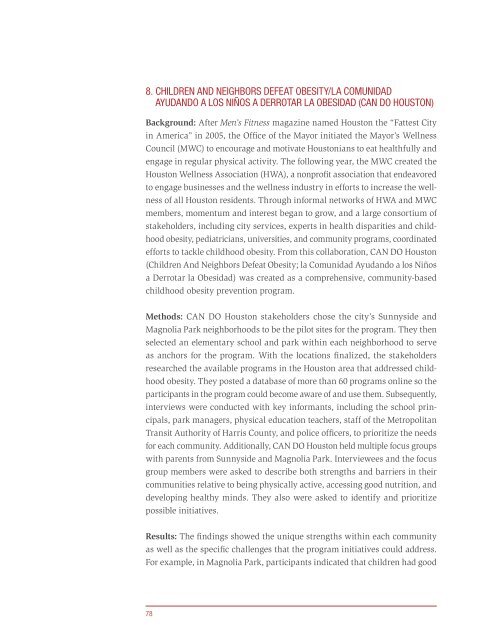Principles of Community Engagement (Second Edition)
Principles of Community Engagement (Second Edition)
Principles of Community Engagement (Second Edition)
You also want an ePaper? Increase the reach of your titles
YUMPU automatically turns print PDFs into web optimized ePapers that Google loves.
8. CHILDREN AND NEIGHBORS DEFEAT OBESITY/LA COMUNIDAD<br />
AYUDANDO A LOS NIÑOS A DERROTAR LA OBESIDAD (CAN DO HOUSTON)<br />
Background: After Men’s Fitness magazine named Houston the “Fattest City<br />
in America” in 2005, the Office <strong>of</strong> the Mayor initiated the Mayor’s Wellness<br />
Council (MWC) to encourage and motivate Houstonians to eat healthfully and<br />
engage in regular physical activity The following year, the MWC created the<br />
Houston Wellness Association (HWA), a nonpr<strong>of</strong>it association that endeavored<br />
to engage businesses and the wellness industry in efforts to increase the well-<br />
ness <strong>of</strong> all Houston residents Through informal networks <strong>of</strong> HWA and MWC<br />
members, momentum and interest began to grow, and a large consortium <strong>of</strong><br />
stakeholders, including city services, experts in health disparities and childhood<br />
obesity, pediatricians, universities, and community programs, coordinated<br />
efforts to tackle childhood obesity From this collaboration, CAN DO Houston<br />
(Children And Neighbors Defeat Obesity; la Comunidad Ayudando a los Niños<br />
a Derrotar la Obesidad) was created as a comprehensive, community-based<br />
childhood obesity prevention program<br />
Methods: CAN DO Houston stakeholders chose the city’s Sunnyside and<br />
Magnolia Park neighborhoods to be the pilot sites for the program They then<br />
selected an elementary school and park within each neighborhood to serve<br />
as anchors for the program With the locations finalized, the stakeholders<br />
researched the available programs in the Houston area that addressed childhood<br />
obesity They posted a database <strong>of</strong> more than 60 programs online so the<br />
participants in the program could become aware <strong>of</strong> and use them Subsequently,<br />
interviews were conducted with key informants, including the school principals,<br />
park managers, physical education teachers, staff <strong>of</strong> the Metropolitan<br />
Transit Authority <strong>of</strong> Harris County, and police <strong>of</strong>ficers, to prioritize the needs<br />
for each community Additionally, CAN DO Houston held multiple focus groups<br />
with parents from Sunnyside and Magnolia Park Interviewees and the focus<br />
group members were asked to describe both strengths and barriers in their<br />
communities relative to being physically active, accessing good nutrition, and<br />
developing healthy minds They also were asked to identify and prioritize<br />
possible initiatives<br />
Results: The findings showed the unique strengths within each community<br />
as well as the specific challenges that the program initiatives could address<br />
For example, in Magnolia Park, participants indicated that children had good<br />
78

















